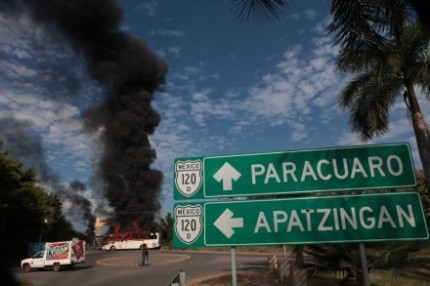The Mexican Attorney General, Jesús Murillo Karam, when asked about what the government should do with the autodefensas (Self-Defence Forces), asked for some time to consider the issue. However, this ‘thinking time’ is precisely why these groups have arisen, with leaders of the autodefensas saying that government ineptitude and collusion with organised criminals is precisely why they have begun to take matters into their own hands. They blame corruption, abandonment of poor communities, and failure to deal with socio-economic inequality for their lack of faith in politicians and the subsequent emergence of community self-defence groups.
The existence of autodefensas came to light in February 2013, so they are nothing new. Their principal aim is to end the extortion communities suffer at the hands of organised criminals – and the murder of whole families who refuse to pay. However, we should remain critical in our support of the autodefensas. For example, the issue of infiltration in the groups by external forces has arisen. On January 4th, ‘Narco-sheets’ signed by the Caballeros Templarios were put up in Apatzingán, showing opposition to the advance of autodefensas. They claimed that former Templario members could be found among the ranks of these groups, and that government bodies also supported the autodefensas’ Council. They also asked where they got their arms and vehicles from.
At the same time, people have the right to defend their communities, and the autodefensas have given people a model to follow. The government has failed to protect people from violence and solve the social problems that cause it, so the organised resistance of citizens seems entirely logical and justified. Hence why, out of 110 councils in Michoacán, at least 40 have autodefensas.
Murillo Karam speaks of how drug trafficking and organised crime ‘suddenly’ became a problem. However, El Mochaorejas, one of the bloodiest and most known Mexican kidnappers, for example, was active in 1995 and 1998. Also, upon the detention of Rafael Caro Quintero in 1985, Mexico was already considered one of countries most involved in the trafficking of marijuana and cocaine into the United States.
In Parácuaro, close to Apatzingán, the municipal president, Lucila Barajas Vázquez, leads a group opposed to the autodefensas. From January 4th, when the autodefensas arrived in the municipality, they met opposition forces who had blocked the road with burning vehicles. Part of the opposition to the autodefensas came from family members of policemen, some of who were detained upon the arrival of the autodefensas. Instead of trying to talk to the newly created autodefensa group in the area, Barajas (who had been on holiday when the self-defence forces arrived) ‘supported’ protests against them – instead of trying to work together to throw the Caballeros Templarios out of Parácuaro.
On January 10th, the battle arrived in Apatzingán. Vehicles were burned and bullet-fire shook the city. Shops were set alight, and soon after so were the offices of the municipal government. A library and other properties were also set on fire. Meanwhile, the road blockades also continued. Government sources claimed the Caballeros Templarios were responsible, while police reports suggested that ‘groups opposed to the autodefensas’ were responsible.
One resident of Apatzingán claimed to have heard ‘the detonation of a grenade just outside [their] house” and that their family was taking shelter with their ‘chests to the ground’. Meanwhile, other inhabitants tried to leave the city.
At the same time, the Federal Government remained powerless and relatively inactive, trying to convince people that the violence was only in small areas. In the face of government corruption, collusion, and incompetence, the growth of autodefensas looks set to continue. And if they remain democratically accountable, the increasing autonomy of Mexican communities battered by drug wars and neoliberal economic policies has the potential to bring about real change.
http://www.proceso.com.mx/?p=362095
http://www.animalpolitico.com/2014/01/por-tercer-dia-consecutivo-registran-bloqueos-en-paracuaro/#ixzz2q1XI1pHe&w
http://www.elblogdelnarco.net/2014/01/los-caballeros-templarios-dejan-mantas.html
http://michoacantrespuntocero.com/el-panico-se-propaga-en-apatzingan-pobladores-temen-por-sus-vidas-testimonios/
http://revoluciontrespuntocero.com/pulsociudadano/comando-armado-prende-fuego-a-palacio-municipal-en-apatzingan/
http://www.youtube.com/watch?v=i8qOWNLy_BQ
http://www.youtube.com/watch?v=OoLNzmqrUuI&feature=youtu.be

